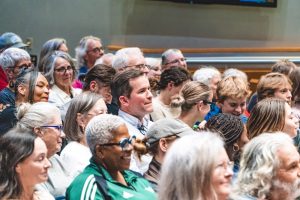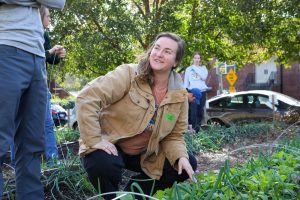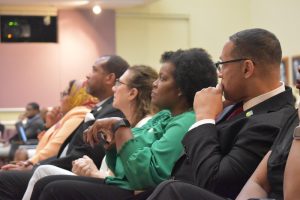Five local Durham parks could be unavailable until the end of the calendar year.
Durham city officials are unsure when East Durham, East End, Lyon Park, Northgate and Walltown parks will reopen amid ongoing investigations of soil contamination.
At a Jan. 27 community forum at Walltown Recreation Center, Durham Parks and Recreation representatives updated residents on efforts to test the contaminated parks.
As weather permits, the North Carolina Department of Environmental Quality, partnering with S&ME Inc., will continue trenching to visualize where waste is present in the parks. Trenching has already been completed at East Durham Park and should wrap up at the subsequent parks by Feb. 7.
“What we’re going to push for is that these probes, [this] testing, can happen as efficiently and thoroughly as possible [so that] by the end of the year, we have all the information we need to make and see some significant impacts and access to our parks,” said Wade Walcutt, director of Durham Parks and Recreation.
The issue first emerged with the discovery of soil contamination in the Walltown and East Durham parks by Enikoe Bihari, a Duke master’s degree student. Bihari’s research, published in late 2022 and reported by the city in 2023, identified contaminated soil in the two parks due to past dumping of incinerator ash.
The soil contamination is mainly attributed to lead, an insoluble element, which is a byproduct of waste incinerators that operated in these areas from 1900 to 1950.
‘When we were growing up, it was never stated’
At the meeting, Durham community members expressed concern about the long-term effects of exposure to the contaminated soil.
“Now what bothers me is to come back to my Walltown, but not hear anyone talk about the effects that [contamination] had on someone like me and people who are dead,” said Thomas Long, 78. “It’s a shame for me to come back here and see that it took 76 years for somebody to discover that these parks were contaminated.”
Long, a retired Walltown resident, grew up in the neighborhood. Health department officials were not present to respond to his concerns about potential long-term health effects from the contaminated soil.
Members of the Walltown community were upset that this issue is emerging now — only as Walltown is becoming more gentrified.
Joseph Blue, a lifelong Walltown resident, spoke about exploring Walltown Park as a kid, as would his grandson years later.
“When we were growing up, it was never stated,” said Blue. “Now, since the community has changed, and you have $500,000 houses, million-dollar houses, now it’s more concerning.”
Terry Singletary, another lifelong Walltown resident, echoed this sentiment.
“They ran the hazard waste down through the Black neighborhoods, so they’re not concerned,” said Singletary. “Now it’s a concern, because 80% of Walltown now is white, so they are affected. They will see their kids are gonna be affected.”
City officials say that they were not aware of the contamination in Durham’s parks before the Duke student’s discovery. DeDreana Freeman, a city council member, said that the absence of past research on lead levels in children suggests local government officials were not aware of the soil contamination.
“If there was a whole swath of children from Walltown who showed up with elevated lead levels, the county would have had to address it,” Freeman said.
Carson Holloway has looked at soil contamination as leader of Duke University’s Locating Toxic Lead in City Soils with Online Archives research team. His team is building upon Enikoe Bihari’s discovery by analyzing online archives of former incinerator sites.
Holloway said that building over dangerous things such as incinerators became more common as Durham neighborhoods grew between the 1940s and 1970s. But over the years, he said, the former practice was largely forgotten.
“The city was caught flat-footed by this whole controversy,” he said. “Nobody knew that there was lead there.”
City officials emphasize that safety is the priority as the investigations continue.
“Our intent is to make sure that these parks and these playgrounds can get open just as soon as possible, but also in a safe way,” said Walcutt.












